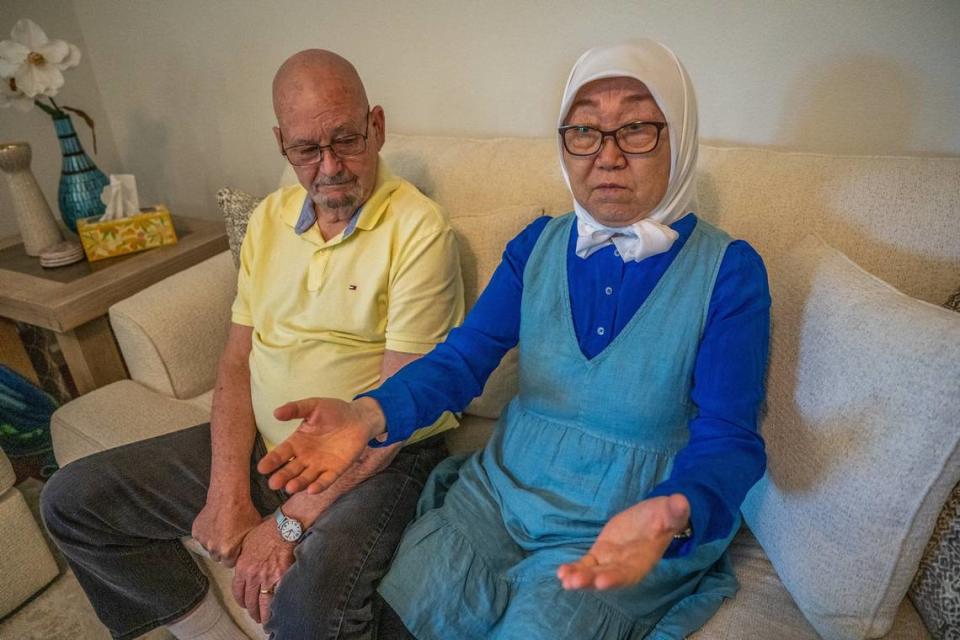Immigration visas can take decades. Just ask this Sacramento mother waiting for her son
Rasia Sharaz Wells happily paid the $355 to file an immigration petition for her son 14 years ago. Wells was hopeful her son, whom she had left behind in Kyrgyzstan — their home country in Central Asia — would arrive within a few years.
Today, Wells, 68, is still waiting while her son’s file inches through a backlog. Authorities have only recently started issuing green cards to people in his immigration category, but that offers no clear indication for when he might receive legal status.
“The legal way is not working,” Wells said, speaking from her home in Natomas. “I don’t know what to do.”
Wells’ more than decade-long wait is not uncommon. As politicians continue to debate immigration policies, Americans seeking green cards for their relatives languish in backlogs of a broken system.
U.S. Citizenship and Immigration Services had 391,000 family petitions cases backlogged as of September 2023. For some people, it will take more than two decades to receive their green card.
In Wells’ case, she is particularly frustrated with what she calls an “unfair” immigration system. She references the thousands of migrants who have crossed the U.S.-Mexico border over the last decade without legal status.
Wells has even heard of families from Kyrgyzstan flying to Mexico and spending tens of thousands of dollars to get assistance to cross the border. All the while, her son Nurbek Jumataev, 45, must wait because she has wanted to do it “the honest way.”
“I am a human being,” Wells said. “I can be jealous. Why not?”
Jumataev, who only speaks Russian, responded to translated questions over WhatsApp.
“Fourteen years is a long time, and it’s not easy,” he said. “We didn’t know that it would last this long.”

‘Immigration system is so broken’
Wells arrived in California in 2000 via an immigration visa. She left Kyrgyzstan to provide a better life for her three children.
The mountainous country, formerly part of the Soviet Union, borders China on the east and south. It began a sharp economic decline in the mid-1990s, which led to a wave of Kyrgyzstan migrants moving to the U.S.
“I was so happy to work and send money to my kids to go to school,” Wells recalled.
She spent years living away from her family and working multiple jobs — cleaning houses and hotels, child care and at gas stations. In between, she enrolled in community college classes to learn English.
“This must be the way all immigrants come up,” Wells said, reminiscing of her days working long hours.
Like many immigrants, Wells aspired to reunite with her children.
Her first attempt to bring a child over was in 2004, when Wells’ youngest daughter gained a visa to enter the country. The then-16-year-old was given priority because of her underage status. But Wells’ son, who was in his mid-20s at the time, remained in Kyrgyzstan.

Wells continued to wait until she met her husband in 2008. When the couple married, Wells gained U.S. citizenship.
Using this new legal status, Wells filed a Form I-130, Petition for Alien Relative, in October 2010. The form is used by U.S. citizens trying to obtain a green card for a family relative including husbands, wives, children, parents, brothers and sisters.
The lawyer helping with the application assured her it would take seven or eight years to obtain the visa, Wells said.
What she didn’t know was that this family-based immigration avenue had been backlogged for decades because of federal limitations and high demand. Lack of immigration reform has worsened the issue.
The average wait time to apply for a green card doubled from 1991 to 2018, according to the Cato Institute, a libertarian think tank. In that time, the U.S. has not updated its green card cap, the maximum number that can be issued annually.
“This (wait) is very normal,” said local immigration attorney Kishwer Vikaas. “I hate to say it, but our immigration system is so broken.”
For certain immigrants, like Jumataev, the average wait time for a green card rose by nearly 12 years.
Jumataev’s wait is particularly long because of his age and marital status. Family-sponsored visas are divided into “preference classes,” with certain categories having priority. As a married man older than 21, Jumataev is in the third preference class. Only siblings of U.S. citizens have lower priority.
Visas for married children of U.S. citizens are capped at 23,400 per year across all countries.
There is a recent sliver of hope for Wells, per a U.S. State Department bulletin that advises applicants when they can expect their visas. As of this month, authorities are issuing visas to people in Jumataev’s category who applied in October 2010.
In an email statement, a U.S. State Department spokesperson said visa records are confidential under law and details of individual cases could not be discussed.
But Jumataev is luckier than other applicants from countries with higher visa demands.
Authorities begun issuing visas this month to Mexicans in Jamataev’s preference category. Those applications were filed in April 2001.
‘Immigration should work’
Over the years, Wells has tried to temper her frustration with the immigration system despite her son missing many family milestones — weddings, birthdays and graduations.
But recently, Wells said she can’t help her feelings of “jealousy” when hearing reports about migrants crossing the U.S.-Mexico border. Negative sentiments toward the border and migrants have risen recently among all Americans, including within communities of color. Experts and advocates note these feelings are often misguided and stem from growing economic inequality.
“She seems to know more people that didn’t follow the rules who got to come here than people who do follow the rules,” said her husband, Ronald Wells.
The family even explored the possibility of doing the same after hearing stories of Kyrgyzstan families paying thousands of dollars to reach the United States via Mexico. These families will often start their journeys in Russia and pay for flights to Mexico, Wells said.
Potential costs quickly ended that idea. Wells said she has heard families are being charged between $10,000 to $15,000 per person. She already sends back money to help her son, who works as a trucker and makes about $400 a month.
Plus, Wells is determined to follow the rules. But even now, with the most recent U.S. State Department bulletin, Wells remains cautious.
“I’m afraid to get excited, until we get the visa,” Wells said. “Then, I will be happy. There’s no trust.”
The 68-year-old dreads the possibility of her death, which until recently would have automatically ended her son’s I-130 petition. An option now exists, which would require applicants to submit a “humanitarian reinstatement” to U.S. Citizenship and Immigration Services.
Requests are determined by the USCIS office and, in most cases, applicants can’t appeal the decision. Timing for these decisions vary.
“Immigration should work,” she said. “They just can’t forget the citizens here.”

